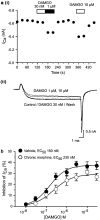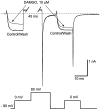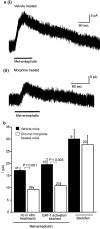Opioid tolerance in periaqueductal gray neurons isolated from mice chronically treated with morphine
- PMID: 15980868
- PMCID: PMC1576256
- DOI: 10.1038/sj.bjp.0706315
Opioid tolerance in periaqueductal gray neurons isolated from mice chronically treated with morphine
Abstract
The midbrain periaqueductal gray (PAG) is a major site of opioid analgesic action, and a significant site of cellular adaptations to chronic morphine treatment (CMT). We examined mu-opioid receptor (MOP) regulation of voltage-gated calcium channel currents (I(Ca)) and G-protein-activated K channel currents (GIRK) in PAG neurons from CMT mice. Mice were injected s.c. with 300 mg kg(-1) of morphine base in a slow release emulsion three times over 5 days, or with emulsion alone (vehicles). This protocol produced significant tolerance to the antinociceptive effects of morphine in a test of thermal nociception. Voltage clamp recordings were made of I(Ca) in acutely isolated PAG neurons and GIRK in PAG slices. The MOP agonist DAMGO (Tyr-D-Ala-Gly-N-Me-Phe-Gly-ol enkephalin) inhibited I(Ca) in neurons from CMT mice (230 nM) with a similar potency to vehicle (150 nM), but with a reduced maximal effectiveness (37% inhibition in vehicle neurons, 27% in CMT neurons). Inhibition of I(Ca) by the GABA(B) agonist baclofen was not altered by CMT. Met-enkephalin-activated GIRK currents recorded in PAG slices were significantly smaller in neurons from CMT mice than vehicles, while GIRK currents activated by baclofen were unaltered. These data demonstrate that CMT-induced antinociceptive tolerance is accompanied by homologous reduction in the effectiveness of MOP agonists to inhibit I(Ca) and activate GIRK. Thus, a reduction in MOP number and/or functional coupling to G proteins accompanies the characteristic cellular adaptations to CMT previously described in PAG neurons.
Figures





References
-
- AKIL H., MAYER D.J., LIEBESKIND J.C. Antagonism of stimulation-produced analgesia by naloxone, a narcotic antagonist. Science. 1976;191:961–962. - PubMed
-
- BAGLEY E.E., GERKE M.E., VAUGHAN C.W., HACK S.P., CHRISTIE M.J. GABA transporter currents activated by protein kinase A excite midbrain neurons during opioid withdrawal. Neuron. 2005;45:433–445. - PubMed
-
- BELLCHAMBERS C.E., CHIENG B., KEAY K.A., CHRISTIE M.J. Swim-stress but not opioid withdrawal increases expression of c-fos immunoreactivity in rat periaqueductal gray neurons which project to the rostral ventromedial medulla. Neuroscience. 1998;83:517–524. - PubMed
-
- BERNSTEIN M.S., WELCH S.P. μ-opioid receptor downregulation and cAMP-dependent protein kinase phosphorylation in a mouse model of chronic morphine tolerance. Mol. Brain Res. 1998;55:237–242. - PubMed
-
- BOHN L.M., GAINETDINOV R.R., LIN F.-T., LEFKOWITZ R.J., CARON M.G. μ-Opioid receptor desensitization by β-arrestin-2 determines morphine tolerance but not dependence. Nature. 2000;408:720–723. - PubMed
Publication types
MeSH terms
Substances
LinkOut - more resources
Full Text Sources
Research Materials
Miscellaneous

